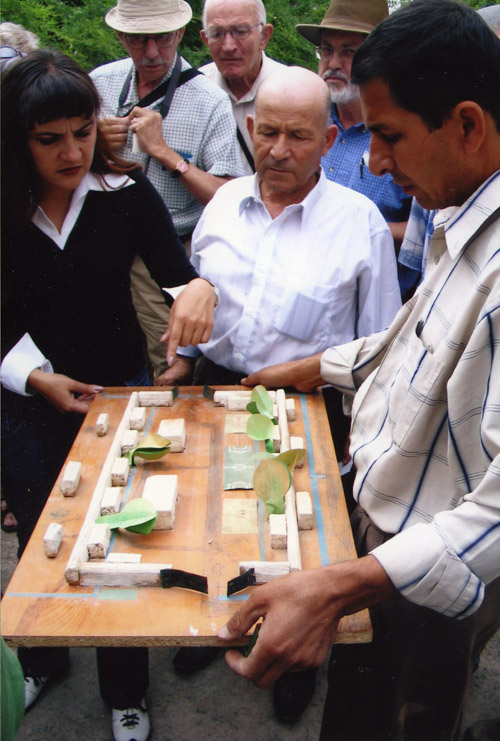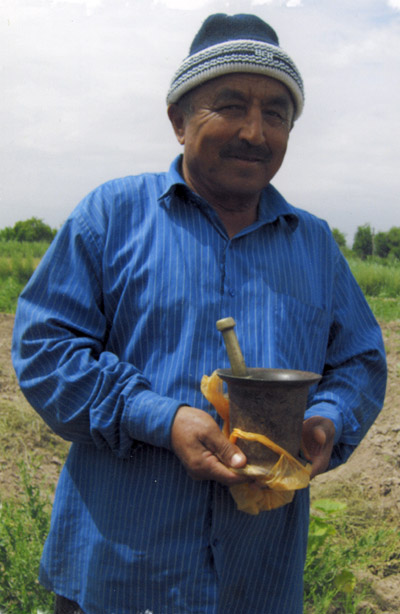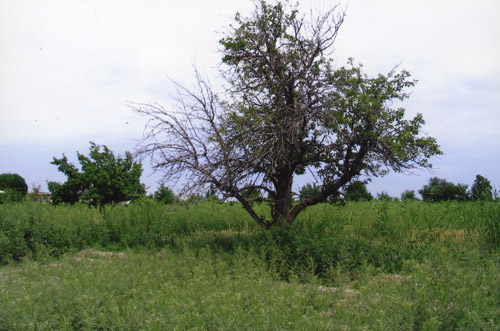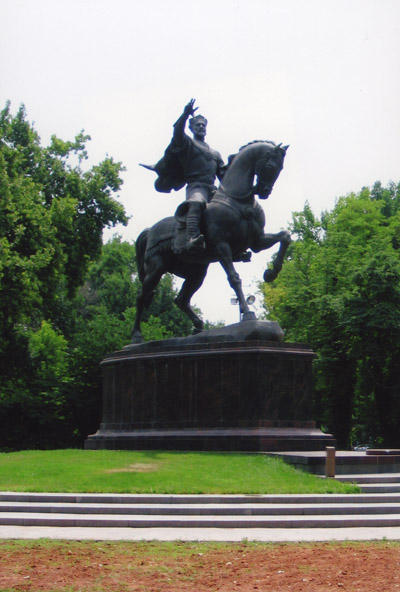
Marina Alleyarova (tour guide, left) and
Sariev Kadambay Malaevich (headmaster, center)
examine a model of the Ak Metchet Mennonite village.(photo by Jim Juhnke)
 Fall 2007
vol. 62 no. 2
Back to Table of Contents
Fall 2007
vol. 62 no. 2
Back to Table of Contents
Duane Friesen is professor emeritus of Bible and religion at Bethel College.
Let me begin by briefly describing the incredible experiences we had the morning of June 6, 2007, at the village of Ak Metchet, a few miles from Khiva, a city along the ancient silk route in what is now modern southwest Uzbekistan. With the help of our guide, Marina Allayarova, we located the village of Ak Metchet where Mennonites lived from 1884-1935, until Stalin's collectivization program ended their community. Ak Metchet means "white mosque," named by Muslim neighbors after the white-washed church where the Mennonites worshiped. This name Ak Metchet given by Muslims to a Mennonite village many years ago is now on the map of modern Uzbekistan.
The morning began with a visit to the Uleg Beg School in the village, a few hundred yards from the location of the Mennonite community. The school is named after the famous astronomer/mathematician, Uleg Beg, who in the 1420s built an immense, three story tall sextant (ruins that were unearthed in 1908), one of the largest ever constructed, in order to measure the positions of the stars with unprecedented accuracy well before Copernicus. We interrupted students who were completing a final exam in physics in order to see two desks at the school that were built by the Mennonites. We exchanged stories with the headmaster and others at the school, and learned that they had a great deal of knowledge about the Mennonites who had lived there over seventy years ago. One of the teachers showed us a "model" of the Mennonite community made by a student at the school. We compared our map with their model. We learned that they want to develop a museum to feature the German Mennonites.

Marina Alleyarova (tour guide, left) and
Sariev Kadambay Malaevich (headmaster, center)
examine a model of the Ak Metchet Mennonite village.(photo by Jim Juhnke)
Our bus took us several hundred yards further adjacent to the site of the Mennonite community. We walked two by two along a dirt path beside the rebuilt wall that had once enclosed the Mennonite community. Today the only buildings remaining are a pioneer camp from the Stalin era. The land is divided into small irrigated plots—grain, watermelon, onions, and potatoes. A family was working in their fields. We exchanged greetings and had fun laughing with several young children, making up actions, counting fingers, pointing to the pictures on their shirts. An elderly villager told us that he had played among the tombstones of the Mennonite cemetery as a five-year-old, though the Mennonite cemetery no longer survives because it had flooded some years ago. Muslims from the village come each spring to the site of the cemetery to pray for blessing on their crops, remembering German Mennonites before them who had been such good farmers. We learned that Mennonites had introduced tomatoes and potatoes, as well as cheese and other dairy products. A villager walked back to his home to bring a brass mortar and pestle that had been given to his family by Mennonites when they were deported in 1935. He said that there were furniture and other artifacts in the homes in the area. The villagers remember the Mennonites as peaceful people who did not use knives to defend themselves. They wanted to know if we still are nonviolent. When we asked them, they said they did not hear the Mennonites talk about their millennial beliefs. We walked and lingered among the small plots of watermelon, onions, potatoes, and grain on the site where Mennonites had farmed, and stood around an old apple and pear tree that we were told had been planted by Mennonites about 75 years ago. Several of the group drew water from the old well.

Mennonite mortar and pestle (photo by Karen Schmidt)
We spent about an hour and a half on this "sacred" ground. Small groups engaged in conversation, while others listened to our guide Marina translate questions and answers from Uzbek villagers who had come to see who we were. Some of us drew apart to ponder the meaning of this place. Then we gathered around the well for worship. Our opening hymn was "Holy God we Praise Thy Name."
"Lord of all we bow before thee.
All on earth thy scepter claim; all in heav'n above adore three.
Infinite thy vast domain, everlasting is thy reign."
Carol Klingenberg read from the Hagar story of Genesis 16 and 20 where we hear the poignant words: "When the water in the skin was gone, she cast the child under one of the bushes. Then she went and sat down opposite him a good way off, about the distance of a bowshot; for she said, 'Do not let me look on the death of the child.' And she sat opposite him, she lifted up her voice and wept. And God heard the voice of the boy; and the angel of God called to Hagar from heaven, and said to her. 'What troubles you, Hagar? Do not be afraid; for God has heard the voice of the boy where he is. Come, lift up the boy and hold him fast with your hand, for I will make a great nation of him.' Then God opened her eyes and she saw a well of water. She went and filled the skin with water, and gave the boy a drink." I then gave the following meditation.
On our pilgrimage through the Ukraine and Uzbekistan, I have been pondering four themes or images that begin to "tell the story" of what we are experiencing. As we gather around this well, Carol Klingenberg's reading of the story of Hagar suggests the theme of "survival in the wilderness." The Hagar story is the central paradigm for African American womanist theologians who tell their story not as liberation from slavery and new life in the promised land, but as a story of women who have, through God's gracious presence, been empowered to survive under difficult circumstances in the wilderness. The Great Trek is such a story.
A second theme or image is "the thread." I hold in my hand a twig from the pear tree planted by Mennonites about 75 years ago. It symbolizes continuity on the land. The wheat we

Pear tree at Ak Metchet (photo by Jim Juhnke)
see growing at Ak Metchet is another thread, connecting us to those Mennonites who lived here a century earlier, and to Muslim villagers who now farm this land. Both symbols remind us of that "great cloud of witnesses,"' our spiritual ancestors, some of whom migrated westward to America while others went eastward to Central Asia. On our journey I have been pondering a poem of William Stafford:(1)
The Way It Is
There's a thread you follow. It goes among
things that change. But it doesn't change.
People wonder what you are pursuing.
You have to explain about the thread.
But it is hard for others to see.
While you hold it you can't get lost.
Tragedies happen; people get hurt
or die; and you suffer and get old.
Nothing you do can stop times unfolding.
You don't ever let go of the thread.
A third theme is the remarkable story of Muslim/Christian relationships that happened in Khiva between 1884 and 1935—an exchange between two peoples who developed friendships and shared gifts with each other that benefitted both communities. I learned from Walter Ratliff, who just completed a master's degree in Muslim/Christian relationships, that Georgetown University has provided some of the funding for the video he and Jesse Nathan are making of our "Great Trek," because of Georgetown's interest in this story as a model of Muslim/Christian relationships, already in the 19th century.
The Mennonites depended for their survival on the policies of the Russian Empire and local political rulers. The Khan of Bukhara forced the Mennonites out of his territory with a military escort. Khan Mohammad Rakhim of Khiva rescued the Mennonites from the raids of Turkoman tribes in Lausan when he invited the Mennonites to settle at Ak Metchet. We could spend some time reflecting on Mennonite two kingdom theology. These were nonresistant people who depended on the protection of a Khan who did not hesitate to use violent force to kill his enemies and who had a harem of over 200 wives and concubines.(2)
The fourth theme is hope. Human beings are creatures of hope. Each day our expectations shape our lives. This morning we began with an expectation of what our day would be like, and then we behaved to fulfill that expectation. The life stories of each of us here today have been shaped by our hopes—to become a father or mother, a teacher or farmer, to respond to the story of Jesus and become baptized into the church. These individual stories are enveloped by larger dreams beyond us that we became part of because of decisions made by others, our ancestors. Our stories began with that great cloud of witnesses who founded the Abrahamic faiths-back to Abraham and Sarah who left land and kindred "not knowing where they were going," according to Hebrews. "By faith [he] they stayed for a time in the land [he] they had been promised. . . . looking forward to the city that has foundations, whose architect and builder is God."
It is difficult to wrap our minds around the profound mystery symbolized by this place, Ak Metchet, the "white mosque." We worship today, mindful of Mennonites who lived here beginning in 1884 for over fifty years in pursuit of a dream to meet Jesus. They lived among Muslims, a people committed to the worship of the One true God. Here lived two peoples on pilgrimages—one to meet Jesus in Central Asia, the other facing Mecca in prayer and the once in a life time pilgrimage to the Kaaba.
One of the most moving experiences for me on this journey is the sign on a beautifully carved gate, made in 1404-1405 to a mausoleum in Samarkand. According to legend, it was the tomb of Kusam Ibn Abbas, who is said to "have the countenance of Muhammad." Behind a wood screen we could dimly see the tomb, and as we entered this quiet place, people were praying. The sign on the gate said, "the doors of paradise are open to all believers." I like to think this sign includes those of us who share in the belief in one God and who practice the virtues of hospitality and kindness that have been so generously offered to us on this journey. "There is a wideness in God's mercy."

Statue of Tamerlane in Tashkent (photo by Jim Juhnke)
In this place the dreams of people of different cultures and religious traditions have intersected in ways that baffle us. We have been traveling in countries, the Ukraine and Uzbekistan, where millions of people, including our ancestors, suffered and died because of dreams of empire—the Mongol Empires of Genghis Khan and Tamerlane; the expansion of the Russian Empire into the Ukraine and Central Asia that opened up farmland for Mennonites; the vision of the Bolshevik Revolution and the chaos of Red and White armies who moved back and forth through the Molotschna villages; the Union of Soviet Socialist Republics; Stalin's plans of collectivization that finally destroyed this community at Ak Metchet; Hitler's Third Reich and the slaughter of Jews at Babi Yar and throughout Europe. We travel as Americans with our country's shameful dreams of Empire, mired in a terrible war in Iraq—hundreds of thousands already killed, several million refugees. Ak Metchet at the same time symbolizes survival in the wilderness as well as profound suffering—not just by Mennonites, but by Jews, Muslims, and millions of ordinary people run over by dreams of empire.
What do we make of this propensity of human beings to dream—the very fine line between the demonic and the creative? What about human dreams leads to dehumanization and destruction, as distinguished from dreams which uplift and revitalize the human enterprise?
What do we learn from the story of Claas Epp, Jr., and the people who followed him? Their lives have impacted many of us on this "Great Trek." Margie Wiebe Johnson, whose grandmother Anna Wiebe Toevs was on the Great Trek and a member of my boyhood congregation, First Mennonite Church in Aberdeen, Idaho, shared this statement from her grandmother:
We were getting along so very well in every respect in Russia, that we surely would have stayed and suffered the later fate of the Mennonites in Russia, had it not been for the emigration to Asia. So even if this trip seemed a needless hardship, it nevertheless served to bring us to America.
We are here to remember those ancestors and fellow pilgrims in the Mennonite faith, both those who stayed here, and those who left to come to North America. We are here to honor them, and to ponder the fateful choices they made. Their choices cause us to ask difficult and maybe even painful questions about our own hopes and dreams. We could easily dismiss them because, after all, they were mistaken. They did not meet Jesus in 1884 as Claas Epp had predicted.
We could say it was a pipe dream, nothing more. It was a dream that caused terrible hardship, sorrow, and suffering, hard for us even to imagine—the loss of twelve young children on the first wagon train whose graves are buried in the sands of the desert.
It would be too easy just to dismiss them. They have much to teach us. As they waited with patience for Jesus' return, they remained faithful to their principles of nonresistance. So far as it was possible for them, they carried out the Apostle Paul's vision to live at peace with all those they met along the way. They lived peacefully with the Muslims in Khiva. They were a people of adventure, courage, a people not content with the status quo. They did not stay put where everything was safe and predictable. We can appreciate their perseverance despite obstacles along the way.
We too need a dream—a vision of life that gives our lives meaning and a larger purpose beyond ourselves. At the center of that dream is Jesus—teaching of the Kingdom of God. Jesus taught his disciples to pray, "Thy kingdom come, thy will be done on earth as it is in heaven." We may understand this dream of the Kingdom differently than those on the Great Trek. I believe Jesus' vision of the Kingdom of God is directed more toward this world—a dream concerned about the larger ecological world, about making peace without war, bridging the gap between rich and poor, for living among people of diverse cultures and religions. Our guide, Marina, has reminded us how much work we have to do in bringing Jesus' message of good news to the poor—as she has told us the stories of people suffering from the ecological disaster of the Aral Sea, and the economic conditions of the many poor in Uzbekistan.
Nevertheless we need the same virtues to live the dream of the Kingdom of God that were embodied in those pilgrims who came to Ak Metchet. May we learn from their courage and readiness to take risks, to leave behind hindrances that keep us from living Kingdom values. May we learn from their persistence through difficulty and hardship. We are all pilgrims. Abraham and Sarah, the founders of the three great monotheistic faiths—Judaism, Christianity, and Islam—"set out not knowing where they were going. . . . looking forward to the city that has foundations, whose architect and builder is God." May we join with this cloud of witnesses to be empowered by God's grace to live the vision of a city whose architect and builder is God.
We concluded by praying the Lord's Prayer:
". . . thy kingdom come, thy will be done, on earth as it is in heaven. . ."
And singing, "There's a Wideness in God's Mercy."
". . . like the wideness of the sea
There's a kindness in God's justice, which is more than liberty.
. . . We make God's love too narrow by false limits of our own,
and we magnify its strictness with a zeal God will not own.
For the love of God is broader than the measures of the mind,
and the heart of the Eternal is most wonderfully kind."
During a time of sharing, Norman Epp, great-great grandson of Claas Epp, led us in a ritual of cleansing and reconciliation. With our hands on our faces, in a gesture of cleansing, we moved our hands downward toward the ground as we released Claas Epp and ourselves from the negativity and pain that has plagued the Mennonite community since the 1880s. Then in a gesture of reconciliation, we lifted our arms back to our bodies and our faces to welcome back into the community Claas Epp and those descendants who experienced the ostracism and pain of so many years, expressing our yearning to become one healed body again.
1. William Stafford, The Way It Is: New and Selected Poems (Graywolf Press, 1998). William Stafford was born in Hutchinson, Kansas, in 1914. He was a member of the Church of the Brethren, and a conscientious objector who served in Civilian Public Service during World War II. For many years he was a professor at Lewis and Clark College, and he became Poet Laureate of Oregon.
2. Later that day we visited the palace of Khan Muhammad Rakhim which he used to receive and entertain foreign dignitaries. He found out that the Mennonites were wood craftsmen, and he wanted his palace to resemble what he had seen in St. Petersburg. In his palace we saw an elaborate bed frame with canopy built by Mennonites that we were told the Khan liked so much that he sometimes used it as his throne. They also built window and door frames for the palace. The most remarkable site is a large wood parquet floor built by Mennonite craftsmen—the irony of a floor made by nonresistant Mennonites in the palace of the Khan.